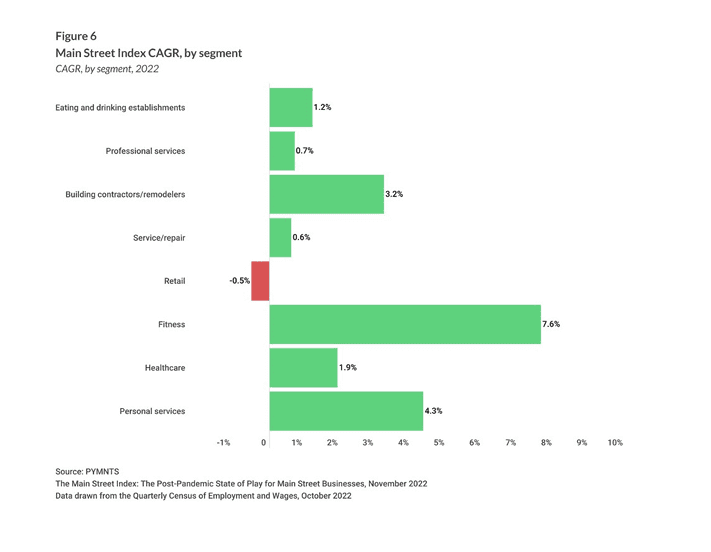Strong Labor Market Skips Main Street’s Small Businesses

Between inflation and a tight labor market, retail’s small businesses can’t catch a break.
The U.S. economy added 263,000 non-farm jobs in November. This was roughly in line with the average growth over the prior three months but lower than the year’s average. The month’s biggest job losses occurred in retail trade, a backbone of Main Street small- to midsized businesses (SMBs). The leisure and hospitality sector led job gains for the month, while notable losses also occurred in transportation and warehousing.
A deeper dive by PYMNTS found wage volatility and inflation have impacted the sector’s growth and profitability. Job vacancies have been particularly challenging for Main Street retail SMBs. In PYMNTS’ November “Main Street Index Q3 2022“ report, Main Street SMBs overall were found to be stabilizing. And in some cases, such as professional services and healthcare, SMBs are settling into a modest growth trajectory since the easing of pandemic-related lockdowns. However, physical retail stores continue to stagnate in an increasingly digital-first sector.

The quarterly PYMNTS Main Street Index indicates that retail has rebounded from its mid-pandemic low point but has contracted slightly in the last year. The severity of the situation becomes more evident when comparing the growth of Main Street SMBs in other sectors. Retailers are the only segment of Main Street SMBs to suffer a long-term contraction.
Unlike businesses in the other segments tracked by the Index, Main Street retail SMBs directly compete with digital-only retailers. This is a tough battle to win, as these SMBs rely on a mix of local consumers and their wider online communities. Without technology infrastructure, Main Street retail SMBs are highly exposed to the impact of accelerated inflation. And, especially for this segment, there has been a shift away from primarily brick-and-mortar patronage to a mix of online and in-store shopping.
Market volatility has also sharply impacted Main Street SMBs. Fears of recession influence consumer spending. Tighter monetary policy restricts businesses’ ability to leverage the affordable financing needed to secure staff and operate smoothly. Until fears subside and policies loosen, Main Street retail small businesses might consider diverse strategies for overcoming these economic obstacles, including a digital platform integration that may reduce administrative labor hours and cut overhead costs.
Transitioning to a fully or partly digital platform to meet today’s challenges can be as varied as the small businesses themselves. Solution examples include a more efficient billing system or payment collections to reduce administrative tasks, real-time inventory tracking and streamlined customer data retention.
Main Street small businesses currently face a fight for economic survival. Incorporating a digital platform strategy as part of a greater business plan could mean the difference between ending the year in the black or the red.
